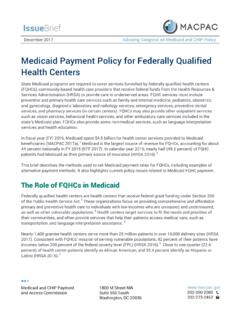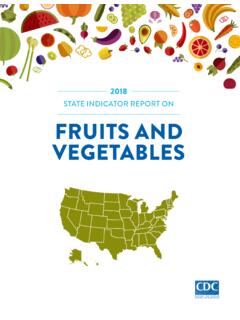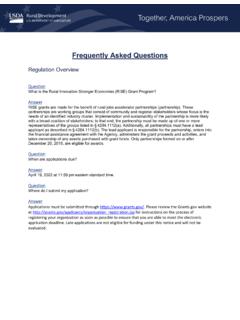Transcription of Competitive Foods and Beverages in U.S. Schools
1 Competitive Foods and Beverages in SchoolsA State Policy AnalysisNational Center for Chronic Disease Prevention and Health Promotion Division of Population HealthFor more information, please contact Division of Population Health National Center for Chronic Disease Prevention and Health Promotion Centers for Disease Control and Prevention 1600 Clifton Road, NE, Mailstop A-11; TTY: 1-888-232-6348 Phone: 1-800-CDC-INFO (232-4636) Web site: CitationCenters for Disease Control and Prevention. Competitive Foods and Beverages in Schools : A State Policy Analysis. Atlanta: Department of Health and Human Services; Foods and Beverages in SchoolsA State Policy AnalysisContentsIntroduction .. 1 Purpose .. 2 Methods ..4 Key Findings ..6 Description of State Policies..6 Alignment of State Policies with Institute of Medicine Standards ..7 Overall Alignment Scores ..7 Overall Alignment Scores by School Level.
2 7 Alignment Scores of Food and Beverage Nutrient Standards by School Level ..8 Scope of State Policies ..9A Closer Look at Each Institute of Medicine Standard ..12 Discussion .. 14 Implications for Practice .. 16 References ..17 Appendix A. Institute of Medicine (IOM) Standards and Related Variables ..19 Appendix B. Citations of State Policies Analyzed ..22iii1 IntroductionSince 1980, the prevalence of obesity among children and adolescents has tripled, and today of children aged 6 11 years and of adolescents aged 12 19 years are categorized as Because youth spend a significant amount of their day in school, it is an ideal venue to promote obesity prevention efforts. A growing body of research has found that the school food environment is associated with youth dietary behaviors and 6 Schools can play a critical role by establishing a safe and supportive environment with policies and practices that sustain healthy behaviors.
3 In addition, Schools provide opportunities for youth to learn about and practice healthy eating and physical students are exposed to a broad range of Foods and Beverages through reimbursable school meals, la carte lines, vending machines, school stores, classroom parties, fundraisers, and other school events. Nutrition standards for federally reimbursable school meals are regulated by the Department of Agriculture s National School Lunch Program and School Breakfast ,8 Current federal regulations for Competitive Foods , which are those Foods sold or available in Schools outside of federally reimbursable school meals programs, prohibit the sale of Foods of minimal nutritional value (FMNV) ( , chewing gum, carbonated soft drinks, certain candies) during meal periods in the food service area, where reimbursable school meals are sold or ,8 However, no federal regulations exist for other Competitive Foods that are also high in calories, fat, sodium, and sugar, but which are not specifically identified as December 2010, Congress enacted the Healthy, Hunger-Free Kids Act of 2010, which requires the development of federal nutrition standards for all Competitive Foods sold in Schools .
4 (For more information, see )2 Competitive Foods and Beverages are widely available in ,9 State and local education agencies have the ability to set rules for Competitive Foods (including FMNV) that are more stringent than federal regulations. For example, states can prohibit the sale of FMNV on the entire school campus for the entire school day, or they can set policies regulating the nutritional content of all Competitive Foods and Beverages in Schools . The Healthy, Hunger-Free Kids Act of 2010 also requires local educational agencies to include nutrition guidelines for Competitive Foods in Schools as part of their local wellness policies. However, because federal officials have not had the authority to create required standards for the content of these guidelines, local policies for Competitive Foods vary widely in strength and Purpose CDC analyzed requirements included in state laws, regulations, and policies related to the availability and nutritional content of Competitive Foods in Schools on the basis of how closely they align with the recommendations in the Institute of Medicine s (IOM s) Nutrition Standards for Foods in Schools : Leading the Way Toward Healthier Youth (IOM Standards).
5 11 The IOM Standards for Competitive Foods and Beverages in Schools are not required by any federal mandate, but they serve as the gold standard recommendations for the availability, sale, and content of Competitive Foods in IOM Standards report concluded that Federally reimbursable school meals programs should be the main source of nutrition in Schools . Opportunities for Competitive Foods should be limited. If Competitive Foods are available, they should consist primarily of fruits, vegetables, whole grains, and nonfat or low-fat milk and milk of Medicine Nutrition Standards for Foods in SchoolsStandards for Nutritive Food Components1. Snacks, Foods , and Beverages meet dietary fat criteria per portion as packaged: no more than 35% of total calories from fat, less than 10% of total calories from saturated fat, and zero trans Snacks, Foods , and Beverages provide no more than 35% of calories from total sugars per portion as packaged.
6 Exceptions to the standard area. 100% fruits and fruit juices in all forms without added sugars. b. 100% vegetables and vegetable juices without added sugars. c. Unflavored nonfat and low-fat milk and yogurt. Flavored nonfat and low-fat milk can contain no more than 22 grams of total sugars per 8-ounce portion, and flavored nonfat and low-fat yogurt can contain no more than 30 grams of total sugars per 8-ounce Snack items are 200 calories or less per portion as packaged, and la carte entr e items do not exceed calorie limits on comparable National School Lunch Program (NSLP) Snack items meet a sodium content limit of 200 mg or less per portion as packaged or 480 mg or less per entr e portion as served la for Nonnutritive Food Components5. Beverages containing nonnutritive sweeteners are only allowed in high Schools after the end of the school Foods and Beverages are caffeine-free, with the exception of trace amounts of naturally occurring caffeine-related for the School Day7.
7 Foods and Beverages offered during the school day are limited to those in Tier Plain, potable water is available throughout the school day at no cost to Sport drinks are not available in the school setting except when provided by the school for student athletes participating in sport programs involving vigorous activity of more than 1 hour s Foods and Beverages are not used as rewards or discipline for academic performance or Minimize marketing of Tier 2 snacks, Foods , and Beverages in the high school setting by locating Tier 2 food and beverage distribution in low student traffic areas and ensuring that the exteriors of vending machines do not depict commercial products or logos or suggest that consumption of vended items conveys health or social for the After-School Setting12. Tier 1 snack items are allowed after school for student activities for elementary and middle Schools . Tier 1 and 2 snacks are allowed after school for high For on-campus fundraising activities during the school day, Tier 1 Foods and Beverages are allowed for elementary, middle, and high Schools .
8 Tier 2 Foods and Beverages are allowed for high Schools after school. For evening and community activities that include adults, Tier 1 and 2 Foods and Beverages are 1 Foods and Beverages for all students. Tier 1 Foods are fruits, vegetables, whole grains, and related combination products, and nonfat and low-fat dairy products that are limited to 200 calories per portion as packaged and 35% of total calories from fat, <10% of total calories from saturated fats, zero trans fat ( g per serving ), 35% of calories from total sugars, and 200 mg sodium. la carte entr e items meet fat and sugar limits as listed 1 Beverages are water without flavoring, additives, or carbonation; low-fat and nonfat milk in 8-oz portions, including lactose-free and soy Beverages and flavored milk with no more than 22 g of total sugars per 8-oz portion; 100% fruit juice in 4-oz portions as packaged for elementary/ middle school and 8-oz portions for high school; and caffeine-free, with the exception of trace amounts of naturally occurring caffeine 2 Foods and Beverages are any Foods or Beverages for high school students after school.
9 Tier 2 snack Foods are those that do not exceed 200 calories per portion as packaged and 35% of total calories from fat, <10% of total calories from saturated fats, zero trans fat ( g per serving ), 35% calories from total sugars, and a sodium content of 200 mg per portion as packaged. Tier 2 Beverages are noncaffeinated, nonfortified Beverages with <5 calories per portion as packaged, with or without nonnutritive sweeteners, carbonation, or sources were used to identify state laws, regulations, and policies enacted prior to October 1, 2010, that govern the availability of Competitive Foods and Beverages in Schools . These sources included the official state government Web sites for all 50 states, the National Association of State Boards of Education s Health Policies database, and the National Conference of State Legislatures Childhood Obesity database. Thirty-nine states have such laws, regulations, or policies, and copies of relevant state policy documents were obtained, including codified laws, state board of education policies, memos, and resolutions for analysis.
10 Eleven states did not have any laws, regulations, or policies related to Competitive Foods in Schools . For this report, the word policy is used as an umbrella term encompassing a state law, regulation, or state board of education guide the analysis, CDC researchers developed and piloted a codebook based on the IOM Standards. Each of the 13 IOM Standards was divided into variables to reflect the complexity of the standard. For example, IOM Standard 1 is divided into 3 variables, and IOM Standard 7 is divided into 11 variables. This process weighted Standard 7 more heavily than the others because it encompasses the majority of standards related to the nutritional quality of Competitive Foods . The process resulted in 33 variables; 28 were applicable for elementary and middle Schools , and 32 were applicable for high Schools (Appendix A).Each of the variables was defined and coded based on the following general rating system, similar to the coding methodology used elsewhere:100 = Variable not mentioned in state policy or is not = Variable is mentioned in the state policy, but only partially meets the variable definition or does not apply to entire school campus or entire school day, or only a certain percentage of Foods or Beverages are required to meet the variable = Variable is mentioned and fully meets or exceeds the variable definition and applies to the entire school campus and the entire school day, or Competitive Foods are example, when coding a policy for the calories variable that snack items must contain 200 calories or less per portion as packaged, the policy would receive a 1 rating if it mentions lowering calories for snacks but does not include a specific calorie level or only sets portion size limits for certain snack Foods .

















